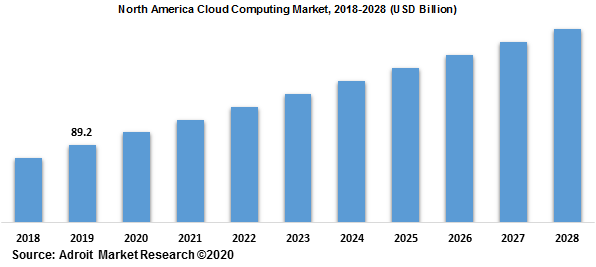The value of the Cloud Computing market is projected to grow to US$ 1,614.10 billion with an estimated CAGR of 17.43% by 2030
.jpg
)
Cloud computing is the on-demand distribution and pay-as-you-go pricing of IT services over the Internet. Instead of purchasing, owning, and maintaining physical data centers and servers, a cloud provider such as Amazon Web Services (AWS) can access technology services, such as computing power, storage, and databases, as required.
cloud computing service providers will benefit from large economies of scale by providing a wide variety of consumers with the same services.
For a broad range of use cases, companies of all types, sizes, and sectors are using the cloud, such as data backup, disaster recovery services, email, virtual desktops, software creation, and research, big data analytics, and web apps facing consumers. Healthcare providers, for example, are using the cloud to create more customized therapies for patients. The cloud is being used by financial services firms to facilitate real-time fraud detection and prevention. And video game developers use the cloud to distribute games digitally to trillions of players around the world.
Cloud Computing Market Scope
| Metrics | Details |
| Base Year | 2023 |
| Historic Data | 2018-2022 |
| Forecast Period | 2024-2030 |
| Study Period | 2018-2030 |
| Forecast Unit | Value (USD) |
| Revenue forecast in 2030 | US$ 1,614.10 billion |
| Growth Rate | CAGR of 17.43 % during 2020-2030 |
| Segment Covered | By Deployment, By Service, Regions |
| Regions Covered | North America, Europe, Asia Pacific, South America, Middle East and Africa |
| Key Players Profiled | Adobe Inc., Alibaba Group Holding Limited, Amazon.com Inc., Google LLC, International Business Machines Corporation, Microsoft Corporation, Oracle Corporation, Salesforce.com Inc., SAP SE, Workday, Inc. |
Key Segment Of The Cloud Computing Market
Service, (USD Million)
• Infrastructure as a Service (IaaS)
• Platform as a Service (PaaS)
• Software as a Service (SaaS)
Deployment, (USD Million)
• Large Enterprises
• Small & Medium Enterprises
End-use, (USD Million)
• BFSI
• IT & Telecom
• Retail & Consumer Goods
• Manufacturing
• Energy & Utilities
• Healthcare
• Media & Entertainment
• Government & Public Sector
• Others
Regional Overview (USD Million)
North America
• US
• Canada
Europe
• Germany
• France
• UK
• Rest of Europe
Asia Pacific
• China
• India
• Japan
• Rest of Asia Pacific
South America
• Mexico
• Brazil
• Rest of South America
Middle East and South Africa
Frequently Asked Questions (FAQ) :
While technology spending in APAC has increased, the setback due to the recent COVID-19 pandemic is imminent. The cloud technology adoption is expected to increase in sectors where the WFH initiative is helping to sustain enterprise business functions. Enterprises having their existing infrastructure are moving toward the adoption of cloud computing services and willing to adopt the hybrid approach so that they could reap the benefits of on-premises and cloud services.
Moreover, SMEs are largely adopting cloud computing services due to their major benefits, such as no initial infrastructure setup costs and the on-demand availability of computing services. These factors are contributing to the growth of hybrid cloud services in enterprises. Moreover, the hybrid cloud offers the benefit of enhanced workload management, increased security and compliance, and efficient integration within DevOps teams.
Deployment Segment
Based on deployment, the cloud computing market has been segmented into the public cloud and private cloud. Each deployment model is defined according to where the infrastructure for the environment is located.
Product Segment
In terms of product, the global cloud computing market is segmented as SaaS, IaaS, and PaaS. SaaS, PaaS, and IaaS are simply three ways to describe how a user can use the cloud for their business The software as a Service (SaaS) segment dominated the cloud computing market in 2019 owing to its flexible costs, easy maintenance, and deployment.
Application Segment
The Cloud Computing market based on application has been segmented into IT & telecom, BFSI, retail and eCommerce, healthcare, manufacturing, government & utilities, and others. Cloud computing is an internet-based computing technology, which is witnessing significant adoption across numerous industries owing to its provision of virtual servers that hosts platform, software, devices infrastructure, and other resources to customers.
Enterprise Size Segment
Based on enterprise size, the market is bifurcated into large enterprises and SMEs. Cloud computing and other technologies in its peripheral such as IoT, AI, blockchain is advancing in leaps and bounds, in turn, rapidly transforming every aspect of business and life. The cloud platforms are leading to a paradigm shift from conventional computing technologies, which is positively influencing businesses of all sizes.
Based on the region the global cloud computing market has been bifurcated into North America, Europe, Asia-Pacific, Middle East & Africa, and South America. These regions are further bifurcated into, North America: U.S. and Canada, Europe: Germany, France, UK, and Rest of Europe, Asia-Pacific: China, India, Japan, and Rest of Asia Pacific, and South America: Brazil, and Rest of South America. North America is expected to have the highest market size in the forecast period.

The major players of Cloud Computing are Adobe, IBM, Oracle, Red Hat, Software AG, Microsoft, and The major players of Cloud Computing are Microsoft, Amazon Web Services, IBM Corporations, Oracle, Salesforce, Cisco, and various other players in the market. Most of the players are spread across various regions focusing on inorganic and organic strategies.

